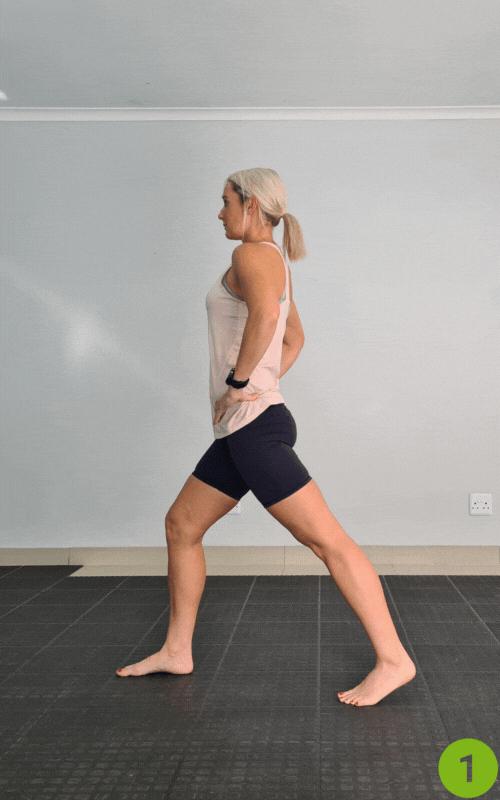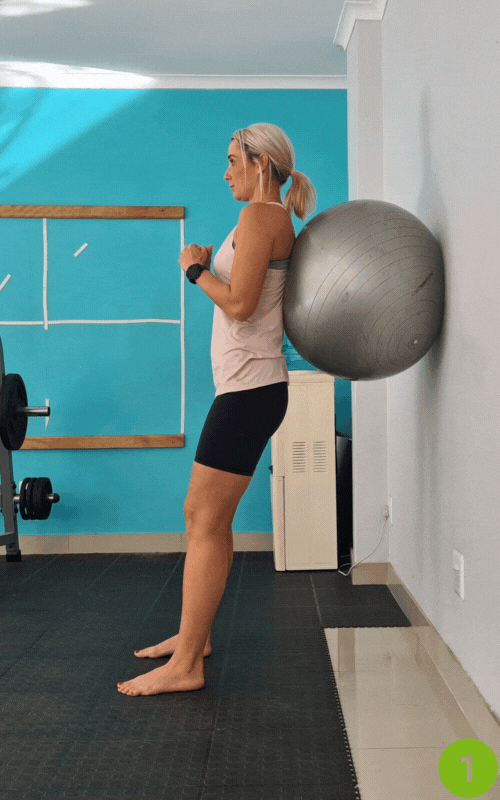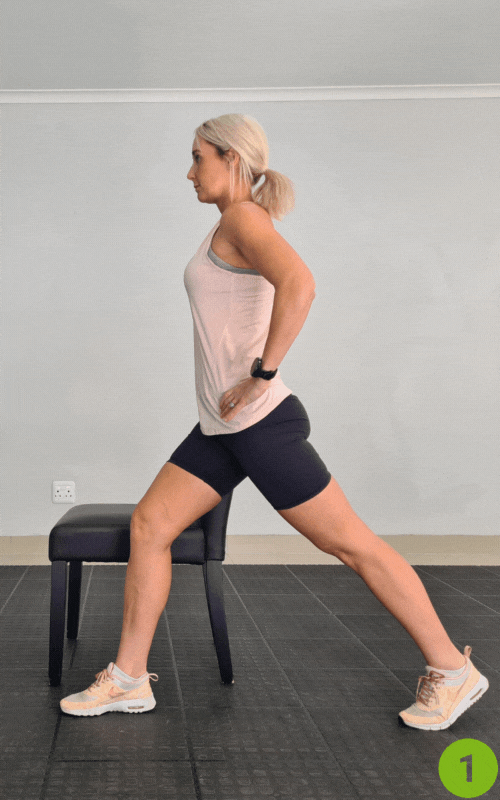Knee pain during squats and lunges is a common issue for athletes, gym-goers, and anyone training their lower body. These exercises are excellent for building strength, but poor form can overload the knee joint, leading to discomfort, often referred to as pain around or behind the kneecap (anterior knee pain).
Pain doesn’t necessarily mean serious injury. With proper technique and the right strengthening exercises, you can reduce strain, recover, and protect your knees. Instead of avoiding squats and lunges, focus on safe adjustments and targeted moves to keep building strength without pain.
Understanding Knee Issues

Knee pain—often caused by patellofemoral pain syndrome—is common with squats, lunges, and other exercises. It usually stems from muscle imbalances, poor movement control, or excess pressure on the kneecap.
Strengthening the hips and glutes, improving ankle mobility [2], and practicing proper form can ease stress on the knee and prevent pain. If discomfort persists, a physical therapist can assess your movement and create a personalized plan to restore healthy function.
Step-by-Step: How to Squat Without Knee Pain

Feet Placement
- Stand with your feet a little wider apart than shoulder-width.
- Keep your feet flat, toes pointing slightly outward. This helps with stability and mobility. Maintain even pressure through your heel, big toe, and little toe to keep proper foot and knee alignment.
Initiate with the Hips
- Start the squat by adjusting your form to accommodate your individual body differences and improve knee comfort.
- Begin the squat by hinging at the hips while allowing the knees to bend naturally, focusing on balanced joint loading.
- Imagine sitting back into a chair—this shifts the load to the glutes instead of dumping force into the knees.
Keep the Heels Down
- Maintain contact between the heels and the ground.
- Press through the heels to rise back up, which engages glutes and hamstrings.
Depth Control
- Aim to lower your hips until your thighs are at least parallel to the ground, adjusting the depth based on your comfort and mobility.
- Lead the movement with your glutes and thighs to maintain alignment and help prevent knee pain.
- Allowing the knees to move slightly past the toes is normal and safe when done with proper form and control.
- Engage your thighs and spiral them outward to support knee stability.
- Avoid collapsing inward at the knees, which often happens due to hip muscle weakness or ankle range limitations.
Step-by-Step: How to Lunge Without Knee Pain

Starting Position
- Stand tall with feet hip-width apart in a standing position. Keep your body aligned, core engaged, and your head in line with your spine and pelvis for optimal posture.
Step and Lower
- Step forward or backward (back lunges are often safer).
- Lower your body straight down, not forward. Focus on vertical movement to reduce stress on the front knee.
Check the Front Knee
- Keep the front knee aligned with your second toe and avoid collapsing inward.
- Pressure should be on the heel of the front foot, not the toes.
Stride Length
- Take slightly larger steps if your knee tends to move past the toes.
- Use a riser or resistance band for extra control and stability if needed.
Engage the Glutes
- Slightly lean your trunk forward—this helps activate the glutes and share the load with the quadriceps, reducing stress on the knee joint.
- Focus on leading the movement with your glutes to ensure proper muscle engagement and reduce knee strain.
Exercises for Pain Relief from Squats and Lunges
1. Wall Ball Squats

Place a ball between your back and the wall, then squat down slowly. This reduces loading on the knees while still building strength.
2. Modified Back Lunges

Step back instead of forward—this puts less force on the front knee joint.
- Hip Strengthening with Resistance Band: Loop a resistance band above the knees and perform side steps. This strengthens hip rotation and glute stability to prevent muscle imbalance.
- Calf and Ankle Mobility Work: Improving ankle range and flexibility helps with smooth motion during the entire knee joint movement.
Preventing Injury During Squats and Lunges
Preventing knee injury [1] in squats and lunges comes down to proper form and strength. Keep your feet flat, maintain knee alignment with your toes, and move with control.
Strengthen the quads, glutes, and hamstrings, and use resistance band drills like clamshells or lateral walks to build hip stability. With good alignment and balanced strength, you can train safely and protect your knees.
Treatment for Knee Pain When Squatting and Lunging

If you consistently feel discomfort, swelling, or sharp pain around the knee cap when squatting or lunging:
- Check Your Form: Improper form is one of the biggest causes of anterior knee pain and patellofemoral stress.
- Modify Movements: Use regressions like partial squats, supported lunges, or ball squats for knee pain.
- Strength Training Balance: Focus on glute muscles [3], quadriceps, and hip muscles to correct imbalances and alleviate pressure.
- See a Professional: A physical therapist or sports medicine specialist can assess whether osteoarthritis, injury, or another condition is contributing to your knee pain.
Some people may experience knee pain even when resting or sitting, especially if there is patellar maltracking
- If you experience sudden, sharp pain or swelling, stop exercising immediately and consult a professional.
Research, including findings from a systematic review, shows that controlled strength training, proper biomechanics, and staying active make a big difference in preventing injury and reducing knee pain over time.
Dr. Michael Fredericson, MD, a professor of Orthopaedic Surgery at Stanford University and sports medicine physician, notes: “Most knee pain during squats and lunges stems from improper mechanics or muscle imbalances rather than structural damage. Strengthening the glutes and improving hip and ankle mobility can make a big difference in reducing anterior knee pain and preventing overuse injuries.”
Lifestyle Changes to Support Knee Health

Knee health isn’t just about exercise—it’s also about lifestyle. Staying active with strength training or low-impact cardio like cycling or swimming builds support while reducing joint stress.
Maintaining a healthy weight, eating an anti-inflammatory diet, and getting proper rest all ease pressure on the knees. Regular check-ins with a professional can catch issues early and keep your joints strong for the long term.
Conclusion
Squats and lunges are powerful lower-body strength exercises, but can cause knee pain if performed with poor form or muscle imbalance.
Keeping the feet flat, controlling hip rotation, engaging glute muscles, and distributing load across the entire movement reduces stress on the knee joint.
Exercises for pain relief, along with modifications like back lunges or wall squats, help you continue building lower-body strength while avoiding injury.
If pain persists, consult a physical therapist or sports medicine expert to develop a tailored program.
Don’t let joint pain hold you back from building strength and staying active. Learn the proven strategies, corrective exercises, and step-by-step guidance designed to eliminate knee pain and protect your joints for life. Check out our Knee Pain Solved today and discover how to move pain-free again!
FAQ’s
Why do my knees hurt when I squat or lunge?
Knee pain often comes from improper form, muscle imbalance, weak hip muscles, or excessive pressure on the knee cap joint. It can also be due to patellofemoral pain syndrome, which causes pain around the kneecap.
Should I stop squatting and lunging if I have knee pain?
Not necessarily. Instead of quitting, try modifications such as back lunges, wall-supported squats, or reducing the range of motion. Always consult a physical therapist if pain is sharp or persistent.
How can I reduce knee pain when squatting?
Keep your feet flat, start the movement from the hips, and avoid letting your knees collapse inward. Focus on distributing the load across the entire movement by engaging glutes, quadriceps, and core muscles.
Are lunges worse for knees than squats?
Lunges can place more stress on the front knee if done with improper form. However, back lunges or modified lunges often reduce discomfort compared to forward lunges, especially if you struggle with anterior knee pain.
Can strengthening exercises actually heal knee pain?
Yes. Research and systematic reviews show that targeted strength training of the glutes, quadriceps, and hips, along with mobility work, can reduce knee pain and improve joint stability over time.


